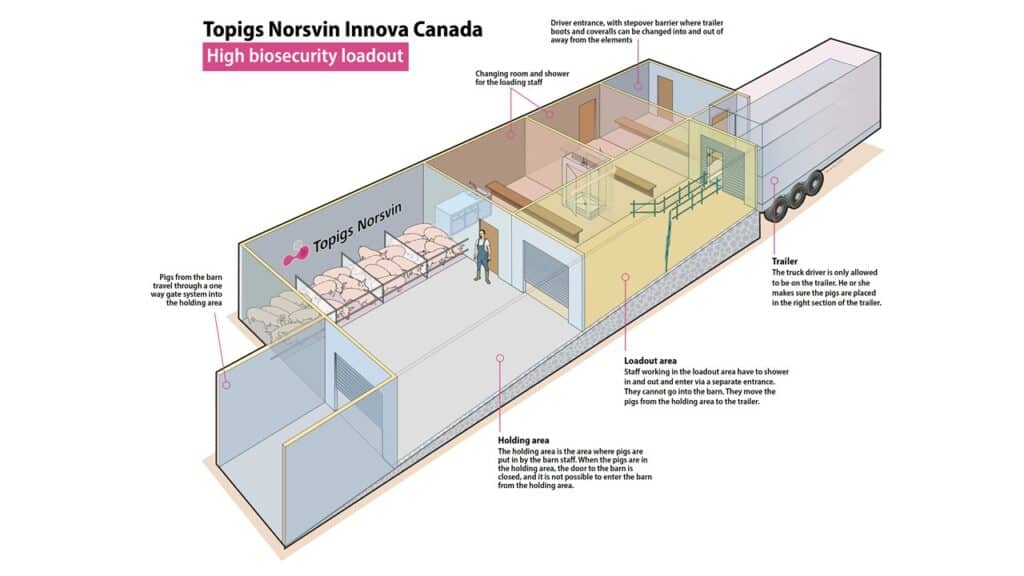Innova Canada will officially open in the second half of September. This latest expansion in the breeding structure of Topigs Norsvin will be the main location for breeding the Z-line, one of the lines of the TN70 sow. Project manager Mike Shaw tells us about some of the interesting and innovative features in this state-of-the-art nucleus.
Innova Canada is the biggest investment in the history of Topigs Norsvin and will lead to increased genetic progress and breeding with future animal welfare legislation in mind. The new nucleus works with a free-farrowing housing system that ensures high animal welfare. But this is just one of the many innovative features. For example, when it comes to sustainability and biosecurity Innova Canada is also setting new standards.
- Free farrowing: first tests show sow is capable and staff is enthusiastic
Innova Canada will use the Pro Dromi Liberté system for sows during the farrowing period. This system can house the sows free with their piglets but also confine the sows during the farrowing process. The piglets have a nest with a microclimate and a warm waterbed floor.
At Topigs Norsvin’s Paradise Valley nucleus farm, three traditional farrowing pens were replaced by two Pro Dromi Liberté units so that our staff could familiarize themselves with the system and find the best way of working with it.
The team experimented with bedding material and when to close in the sow. Mike Shaw, Project manager Innova Canada: “The staff were amazed by the new system. They were so enthusiastic that they could not stop talking about it and they discovered that it did not really involve much extra work. It’s just two pens so far and we’re still learning, but it looks a very good system and the staff enjoy working with it.”
That is also partly due to how sow behaves in the free farrowing pen. She really expresses her mothering abilities in a positive way. They are really good mothers that take care of their offspring. Mike Shaw: “They observed sows that directed the newborn piglets to their nest after farrowing and then laid down in front of the entrance. It looked as if they were training the piglets where their part of the pen is.”
- Biosecurity: loadout to minimize the disease introduction
A top breeding facility like Innova Canada requires the highest possible biosecurity. A crucial aspect is the location of the facility. The next nearest location with pigs is more than 10 kilometers away. Furthermore, the design of the nucleus site ensures that crossovers between barn staff and external traffic are avoided. Materials that need to enter the barn are disinfected with UV in the case of smaller items or fumigated for 48 hours and stored in a dry storage area in the cases of larger items. Other measures to keep disease out are also taken.
A special biosecurity feature are the loadouts. It is a three-step one-way system. It is not possible for pigs to go back into the barn again when they are on the loadout. The first section of the loadout is the holding area where pigs are put in by the barn staff. When the pigs are in the holding area, the door to the barn is closed, and it is not possible to enter the barn from the holding area.
The second section is the actual loadout area. Staff working there have to shower in and out and enter via a separate entrance. They cannot go into the barn. They move the pigs from the holding area to the trailer.
The third section is the trailer. The truck driver is only allowed to be on the trailer. He or she makes sure the pigs are placed in the right section of the trailer. There is a driver entrance in the loadout where the driver can change clothes and boots. At most farms, this needs to be done outside the truck. Mike Shaw: “In cold and windy winter weather that is not an optimal situation and often involves a balancing act on the footboard or loading shelf of the truck.”
When the loading is finished, the whole loadout is cleaned and disinfected.


- Sustainability: Electric heating for fewer emissions and better barn climate.
Innova Canada runs entirely on electricity and uses no fossil energy sources like propane or natural gas. As 97% of the electricity is from hydropower, the nucleus uses renewable and virtually emission-free energy.
Electricity is also used to heat up the water that heats the barn. Mike Shaw points out an interesting side effect of this. “This kind of heating creates a dryer heat than the heating systems normally used in Manitoba. In the winters we have over here, this leads to a better barn climate for the pigs and the staff.”
Therefore the choice to go for 100% electricity not only contributes to lower carbon emissions. It also means lower costs, as natural gas and propane have become far more expensive than electricity and do not enjoy the lower carbon tax.


